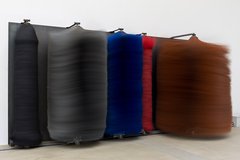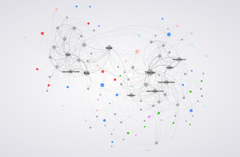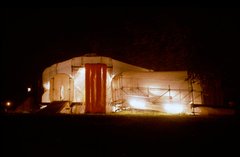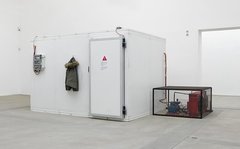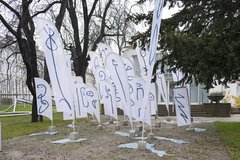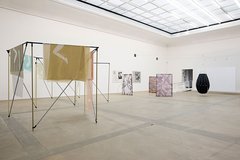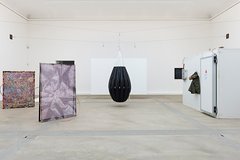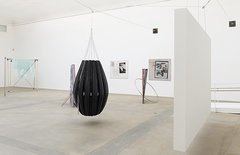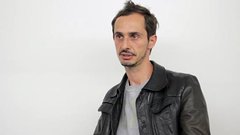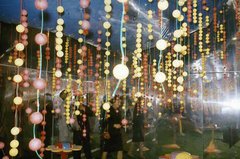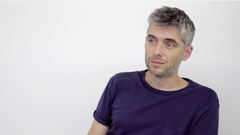In "Environment as a Place of Disquiet," Italien art critic and historian Antonio Grulli constructs an associative history and definition of disquiet spaces, leading to a reflection on art's contemporary situation. Grulli calls for a new understanding of the presentation of art beyond our "transparent" institutions and the white cube.
Environment as a Place of Disquiet
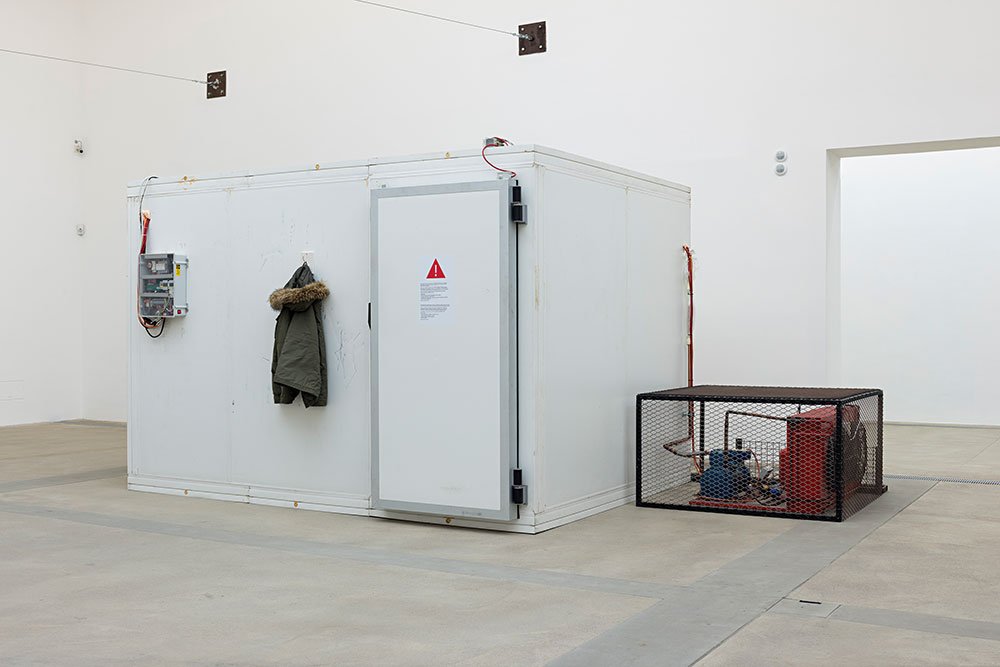
To my mind, space and environment are the crucial dimensions and issues of art today. In contrast to time, which defined art until the mid of the last century and followed the idea of historical-progression, the concept of space is the battlefield for many innovations in recent years. In my thesis, environment is both meant as the space made by the arts and the space made for the arts.
In the context of trigon this becomes even clearer. trigon’s strength, in my opinion, is not in being like every other big art event, based on an abstract or limitless and therefore all-encompassing general art scene, i.e. the “international art scene,” but in being specifically rooted in a precise environment, comprised by three large cultural areas. In addition, these three areas are slightly off the mainstream art circuit.
Unfortunately, interesting places as well as interesting people, often have a problematic background. In this case, the borders that define the project’s geography were for centuries the point of friction for wars and conflict. But I do not want to complain. Instead, I see all these obstacles as a possible source of development, in the same way that trigon attempted to overcome our communities’ past.
Pier Paolo Pasolini, who lived in this region for many years, was once asked to position himself between the field of tradition and the field of avant-garde/experimentation in the literature debate of the 1960s. He replied by saying he was not going to decide. He said his position was in between the two front lines of opposing armies—in the middle of the battlefield— were the blood is spilled. This is also the position of today’s art about which I will now write.
When I was invited to take part in the trigon symposium in Trieste, its theme ambiente nuovo / post environment immediately made me think of the work of Micol Assaël and the notion of negative environment, or what I call disquiet environment (to use an adjective I’ve worked a lot around in the last years) as a possible source of new art, new meaning, and new content. I’ve always been a great admirer of her work and Assaël follows a path that somehow gets close to the development my work has taken recently. As institutional critique underlined, the question of art today is also an architectural and spatial issue, especially if you consider it from a curatorial point of view. When I plan a show it is not only a question of which works are put together, and why these works can share space, but also and particularly how to choreograph these works in a meaningful space and “architecture.” It is both a physical and symbolic space. That’s why in this text I will pass with freedom from the question of space and environment to the question of art institutions, since the two questions are connected in my thesis.
A couple of years ago, I wrote a manifesto that I presented during a symposium in Prato at the Pecci Museum, focusing on the notion of the institution as a place for debate and discussion. The last lines of my text read: “We know very well who yesterday’s and today’s artists and intellectuals are that we have to look up to. Why then can’t a museum director act like Pier Paolo Pasolini, Lars von Trier or Gilles Deleuze? Why do we study today’s exhibitions like the one Harald Szeemann set up to feature his grandfather if it is however very unlikely that something akin would happen in a museum in 2016. Why is it so hard to imagine, for example, an artist as director of a museum or a public institution? Can the institution be a producer of sense, or should it limit itself only to be a re-producer of meanings already established elsewhere, already frozen and therefore already commonplace? Reflection can only come from an initial feeling of disorientation, of crisis, of craving to understand what is really new, the institution must not become a place of appeasement, only called to put its own stamp on things which have already been decided somewhere else. It must be a place capable of producing a surplus of meaning compared with normality, able also to give scandal, a place that is alive, that can accommodate the obscene or anything that is not already on the scene. This is why I speak of disquiet. I use this term because I like to imagine these buildings as if they were endowed with feelings and passions. As if they were persons, capable of shaking with their fears, their flaws and their tendency to make mistakes. Do we want the institutions to be bureaucratic entities trapped between the two polarities of paternalistic education and entertainment, or do we want them to be real places of culture and reflection with all that it entails? Why should we ask a museum to live a life that we would never want for ourselves? I would like the institution to be a place from which to ignite conflict, with the ability to become a place of resistance to the prevailing clichés. It must be a restless, telluric, an almost criminal place, where parents are afraid to allow their children to go, and not a place of deportation, concentration and detention of hordes of children with felt-tips in their hands. Only then will it become a place of reflection, and not a place of reassurance of our most banal platitudes.”
In this quote you can find issues that relate to the work of Micol Assaël, which, in my opinion, are particularly meaningful for the moment we live in. There are passages in my text where it seems I am already describing one of Assaël’s environments. I have this vivid impression from a sign outside of one of her works, cautioning that on entrance it could be dangerous for people with heart problems and pacemakers. In an age where the rhetoric of “art for everyone” rules the museum, I find it fascinating to actually experience art with a “physical” limit. This is why I decided to explore the work of Micol Assaël and to talk about the idea of disquiet in exhibition spaces on this occasion. It is why I will focus on the exhibition space as a trembling environment, a space of danger, in which we can experience fear and get close to the idea of danger. Finally, it is also why I talk about the environment of conflict.
Andy Warhol once said “All department stores will become museums, and all museums will become department stores.”[1] This statement has become true. We can see it every day in our cities and on our streets. But maybe we are on the verge of a transformation; here and there, I can see the first little signs of change. For the reality today is again another and I would reformulate Warhol’s statement to:
All museums will become military compounds, and all military compounds will become museums.
We are facing a process of militarization of art places. In addition to the Louvre terrorist attack in February 2017, reminding me of a scene of guerrilla warfare, the Bardo Museum in Tunis was also attacked in March 2015. All the museums in the world are filled with security cameras in every corner. Many have metal detectors at the entrance combined with security similar to the checkpoints we face in the airport or in places of police and state control. At the same time, we can see that all over the world the erasure of art heritage sites, like in Palmyra and Nineveh, is used as a weapon in times of conflict. Italy is currently leading an international discussion that will probably introduce the constitution of Blue Helmets for Culture, a body of United Nations officers tasked with the protection of the world’s cultural patrimony. And, in the future, we will witness more archeological and cultural heritage sites surrounded by fortification. But, this is not the first time art is in a troubled situation. Actually, art has always been affected by conflict, calling to mind the images of seemingly empty museums and artworks cocooned by structures made to protect them from bombing during the Second World War.
Art and images have been a source of conflict in the many iconoclastic clashes we have faced throughout history. A year ago, I went to Matera in the south of Italy. Probably many of you have been as well and have seen this city built in a canyon. During the 8th century many people took refuge here, in order to survive the war against the use of images in the Christian religion that started in the Eastern Roman Empire. They reached this hidden place, in the region today called Basilicata, and started living in the natural caves in the canyon. The inhabitants covered the surfaces of these caves with images of Christ and saints, using them as churches, and turned the remaining caves into houses still used as homes today. This iconoclastic war continued in the protestant time, and still continues today as we are faced with these disasters unimaginable some years ago.
As we can see, art today is somehow in the same position as Pasolini: in between the front lines, on the edge of friction, where energy has its source, and the position of the intellectual—or the human being—is in danger, sometimes fiscally, always existentially. This feeling is echoed in many of Assaël’s works and environments. I have always considered her work from an existential point of view, as she also suggests this herself. In addition, the artist’s closeness to Russia along with the cultural heritage of that continent makes me connect her work to Dostoevsky ’s book Notes from Underground. Assaël’s spaces are somehow a “real” and symbolic representation of how we could imagine the place where the main character in the book spends his life. Dostoevsky uses the spaces and architectures we live in as a metaphor for the human condition, highlighting the counter position of the underground space and the revolutionary Crystal Palace building in London. The Crystal Palace is the symbol of progress, of faith in the power of rationality, and collective happiness.
In the Crystal Palace pain and suffering are inconceivable because suffering means doubt, negativity, and a shadow over our lives. But in many cases our individuality is shaped more from pain than from happiness. In a crystal palace the concept of rebellion (individually, existentially, and socially) is also inconceivable since control is complete. From this perspective, the miserable basement where the underground man lives becomes a symbol of freedom. Why then, can we not try to see this moment, with all its “dark” sides as a possibility to create new approaches in art and exhibition making? Could we not consider negative space, the “underground” space as a way to get beyond the white cube, the crystal palace of curating and contemporary art?
Sometimes we forget that human beings lived underground more often than expected. Underground, or could we say, hypogeous architecture has been a solution not only in the Stone Age or the Sassi di Matera. Some of the first steps in the arts took place in caves. Symbolically, there is a dichotomy between over ground and underground architecture, a dichotomy that conjures the opposition of the city of life and the city of death. And, in the idea of the city of death we again face a negative environment.
In the past, many artists and architects have worked with the idea of negative space. One of the first to be completely aware of it was Piranesi, an artist not by chance from Rome like Assaël. Just think about his underground Carceri work and its visionary rethinking of ruins. Today’s architects also incorporate the underground or negative space into their designs. For my work, Hans Hollein has always been a huge source of inspiration. The project he proposed for a Guggenheim in Salzburg is just astonishing, and it comes as no surprise that it was never realized: it’s too disturbing. But, in a future where museums are under attack this underground museum could be a possible answer.
One of the recent and most interesting spaces going beyond the idea of the white cube and beyond the trend of “transparency” in architecture is the Boros Collection in Berlin, which is shown in a World War II Bunker in the city center. Over the last decades, it was used for different purposes until the Boros family bought it to exhibit their collection. All the rooms have basically no windows and in many cases we can feel the disquiet of its troubled past.
[1]
#_ftnref1
Rob Walker, “Museum Quality,” New York Times, January 9, 2005, http://www.nytimes.com/2005/01/09/magazine/museum-quality.html
